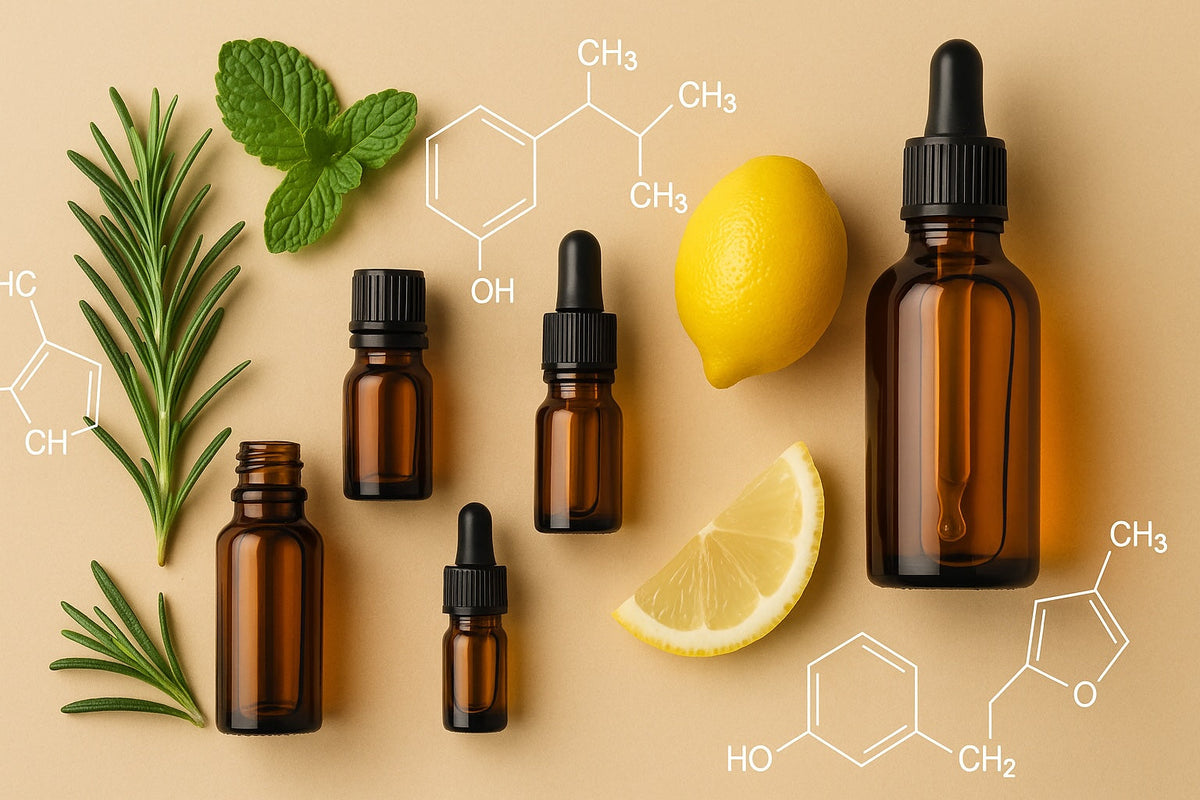
The Science of Essential Oils: What They Are Made Of and Why It Matters
|
Time to read 3 min
|
Time to read 3 min
Essential oils may seem like simple aromatic extracts, but beneath their delicate fragrance lies a complex world of molecular architecture, bioactivity, and botanical intelligence. At Delune, we don’t just believe in the beauty of scent—we honour the chemistry behind it. This deep dive into the science of essential oils will help you understand how these natural compounds work, why they’re effective, and what sets truly therapeutic oils apart from synthetic imitations.
Essential oils are volatile, aromatic compounds extracted from plants. Volatility means they evaporate quickly, which allows them to disperse through the air—and be absorbed when you inhale them. But they're far more than fragrance. They’re made up of hundreds of bioactive constituents that interact with your body’s systems: skin, bloodstream, even the limbic brain.
Many of these molecules are based on a five-carbon unit called isoprene (C5H8), which forms the foundation for the vast family of compounds known as terpenes (including monoterpenes and sesquiterpenes). Others belong to entirely different chemical families, each with distinct structures and properties.
Lightweight and volatile, monoterpenes make up the crisp, uplifting top notes of many essential oils. Found in oils like lemon, orange, pine, and frankincense, they’re responsible for that immediate zing you smell.
Therapeutic properties:
Stability tip: Monoterpenes are highly reactive. Store citrus oils in a cool, dark place and replace within 6–12 months to prevent oxidation and skin irritation.
These molecules are larger, heavier, and more stable—making them ideal for grounding base notes. Found in vetiver, spikenard, and chamomile matricaria, they stay on skin and fabric for hours.
Therapeutic properties:
Did you know? The vivid blue hue of chamomile oil comes from a sesquiterpene called azulene, known for its skin-soothing, anti-inflammatory magic.
Phenols are fierce. Found in clove, cinnamon, and thyme thymol, they’re potent and sharp—powerful antiseptics and immune boosters.
Therapeutic properties:
Use caution: Phenols are intense and should be diluted to 1% or less. Avoid for sensitive skin, children, or pregnancy.
Bright, lemony, and emotionally clarifying. Found in lemongrass, citronella, and Melissa, aldehydes calm the nervous system while lifting the spirit.
Therapeutic properties:
Handle with care: Aldehydes oxidize quickly and can irritate skin—keep blends at 1% or lower.
Powerful but controversial. Found in rosemary (ct camphor), helichrysum, and peppermint, ketones can support healing—but must be used responsibly.
Therapeutic properties:
Warning: Some ketones (like pulegone) are neurotoxic. Always research your oils and avoid ketone-rich blends if you have epilepsy, diabetes, or liver issues.
Sweet, fruity, and gentle. Esters are the darlings of relaxation oils—found in lavender, bergamot, and Roman chamomile.
Therapeutic properties:
Note: Some esters (like methyl salicylate in wintergreen) can thin the blood—avoid with anticoagulants.
Rare but powerful. Found in tonka bean, cassia, and elecampane, these trace compounds have outsized effects.
Therapeutic properties:
Risks: Coumarins are photosensitising (especially in bergamot). Use with sun safety in mind.
Chemotypes are like botanical personalities—same species, different chemical makeup. For example:
Research shows the aroma of a flower changes once it's picked. This living scent, known as the headspace, is influenced by time of day, harvest method, even flower colour. It's part of what makes whole plant oils so unique—and why synthetic scents just don’t compare.
When you isolate one compound, you lose nature’s synergy. At Delune, we honour the full-spectrum intelligence of the plant—not just the "active ingredient," but the subtle, powerful orchestra of compounds working in harmony.
When you use a Delune oil, you're not just using a chemical.
You’re working with scent, energy, and soul—all captured in a single drop.
Essential oils are potent. Always dilute before use on skin, avoid contact with eyes and mucous membranes, and consult a professional if you are pregnant, nursing, or managing a medical condition. For more on our testing and quality control, see our PristiQuant™ page.